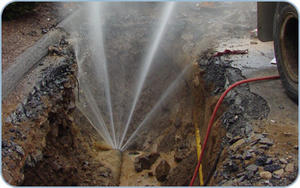Infrastructure / the water we drinkSiemens's leak location and monitoring system reduces losses in drinking water supplies
Precise knowledge of water losses is essential for operating and planning the maintenance of drinking water networks efficiently; Siemens’s new solution not only continuously checks for leaks, but also pinpoints them automatically; this is done by setting up district metering areas, in which the inflows and outflows of water are measured by ultrasonic flow meters

The overwhelming majority of leaks are not this easy to find // Source: fscleakdetection.com
Together with Siemens Corporate Technologies, the Siemens Industry Solutions Division has developed a method of finding and continuously monitoring leaks in water pipes. Siwa LeakControl is based on flow measurements and special software for evaluation. It can be used with all sizes and types of pipes, and helps to keep water losses as low as possible.
Precise knowledge of water losses is essential for operating and planning the maintenance of drinking water networks efficiently. The condition of the pipes cannot be continuously monitored, but an indication can be obtained, for example, from the volume of water losses. There is a wide variety of ways of doing this, but they are generally only applied at selected points.
For example, some are based on the evaluation of noise levels emanating from leaks in the networks of water pipes. This investigation is performed either at regular intervals, such as annually, or only when leaks are suspected. Such a procedure, however, makes it difficult to detect a suspected leak immediately.
The company says that this is the strength of the new Siemens Siwa LeakControl location and monitoring system, which not only continuously checks for leaks, but also pinpoints them automatically. This is done by setting up district metering areas, in which the inflows and outflows of water are measured by ultrasonic flow meters. Existing measuring systems, such as magnetic inductive flow meters, can also be integrated. The measurements are passed to an evaluation system, which detects leaks and allocates them to the individual zones by statistical methods and a model-based, network-wide mass balance.
The suspected leaks are then found by temporarily installed acoustic sensors, and finally pinpointed down to the exact meter by correlators.
